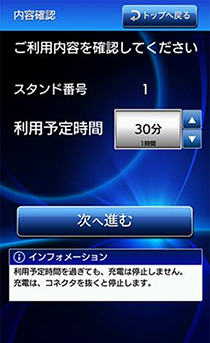December 17, 2015
Toyota Media Service Corporation
Toyota Industries Corporation
Nihon Unisys, Ltd.
Verification project begins on optimized EV/PHV charging based on charging schedule through coordination of multiple-vehicle chargers.
The following three companies embarked on the verification project in July 2015, under appointment by the Ministry of the Environment as promotion businesses for an electric vehicle (EV) and plug-in vehicle (PHV) usage promotion platform under the FY2015 Low Carbon Technology Research and Development Program. From December 19, they will begin verification into electric power control in multiple-vehicle chargers.
Toyota Media Service Corporation (head office in Nagoya City, Aichi Prefecture; president, Shigeki Tomoyama; "Toyota Media Service")
Toyota Industries Corporation (head office in Kariya City, Aichi Prefecture; president, Akira Onishi; "Toyota Industries")
Nihon Unisys, Ltd. (head office, Koto-ku, Tokyo; president, Shigeru Kurokawa; "Nihon Unisys")
In order to promote the widespread use of EVs and PHVs in Japan, the three companies are currently engaged in the development of an EV/PHV usage promotion platform that manages information on the locations and status of charging stations across the country. They are also developing a national charging station infrastructure smartphone app so that people can easily access information gathered by the platform.
Users of the "Nationwide EV/PHV Charger Map" can register the time they plan to charge their vehicle so that other users can check how busy the charger will be. The verification project aims to control electric power at multiple-vehicle chargers using information about planned charging times.
When multiple EVs or PHVs are charging at parking spaces in public or commercial facilities, it is necessary to control the amount of supplied electricity based on the facility’s capacity and the amount of contracted electricity. Until now, electric power was supplied uniformly to multiple vehicles regardless of users’ planned charging times, thus causing problems with the electric power supply for users seeking short charging times.
In the system used in the verification project, a priority charging scheme will be introduced at multiple-vehicle chargers to provide more power to vehicles requiring shorter charging times, based on information gathered on planned charging times. It is also expected that this system will improve the efficiency of energy use and reduce operation costs by efficiently distributing of peak power based on facility capacity and contracted electric power supply.
With the cooperation of Uny Co., Ltd. (head office in Inazawa City, Aichi Prefecture; president, Norio Sako), the project will look into CO2 emission reductions achieved by improving usability and efficiency of chargers at large-scale commercial facilities through the introduction of the priority scheme.
Project summary
| 1.Project period: | December 19, 2015 -- January 15, 2016 |
|---|---|
| 2.Location: | Apita Nagoya Airport Store (Airport Walk) 1-8 Hayashizaki Toyoba, Toyoyama-cho, Nishikasugai-gun, Aichi Prefecture |
| 3.Description: | 1) Register planned charging times with the national charging station infrastructure map app or the charger 2) Power control in multiple-vehicle chargers for prioritized power supply to vehicles requiring short charging times |

(Enter the estimated using time)
Smartphone app screen
(Confirm the status below)
Charging time input screen for charger
The description of the verification project and the technology used is as follows.
1.Description of the verification project
The project aims to greatly reduce CO2 emissions. It is part of the Ministry of the Environment's initiatives to grant private businesses, public research institutes, and universities with commissions or subsidies for the development and verification of technologies that excel in reducing CO2 emissions for more effective measures against global warming in the future. Its official name is "Low Carbon Technology Research and Development Program."
The project is currently in the verification phase. Using the EV/PHP use promotion platform and its connected national charging station infrastructure map app, which were developed last year, the project is being implemented with the support of Aichi Prefecture, which offers a developed EV charging infrastructure.2.Technologies used in the project
1) EV/PHV usage promotion platform
An integrated data infrastructure developed by Toyota Media Service that gathers information on chargers, promotion of EV/PHP usage, and CO2 reductions resulting from this.2) National charging station infrastructure map
A national map that shows electric power charging infrastructure with a high coverage rate, integrating electric power charger data from Toyota Media Service, Toyota Industries, and Nihon Unisys. It also gathers information from Aichi Prefecture and other administrative institutions and related organizations.
Android and iOS versions are available.https://www.evphvchargemap.com/Support/3) Data communication from charger users and owners.
A data communication function that allows users or owners of electric power chargers to transmit information about the facilities.4) Electric power control system for multiple-vehicle chargers
A function developed by Toyota Industries for maintenance of uniform power supply and control of peak supply at charging stations where multiple-vehicle chargers have been installed.5)Power charging waiting time forecast algorithm
A function for forecasting future charger waiting times and congestion, based on big data collected by "smart oasisR," an electric power charging infrastructure systems service provided by Nihon Unisys. It aims to alleviate the power charging congestion that is expected to grow with the increase in the number of EVs and PHVs. Nihon Unisys expects to use the know-how gathered from this verification project for the development of various services using the charger waiting time algorithm.
Related URL
Uny Co., Ltd. http://www.uny.co.jp/corporate/index.html
- * smart oasis is a registered trademark of Nihon Unisys, Ltd.
- * iOS is a trademark or registered trademark of Cisco Systems in the US and other countries and is being used based on licensing.
- * iPhone is a trademark of Apple Inc.
- * The iPhone trademark has been licensed by Aiphone Co., Ltd.
- * Android is a registered trademark of Google Incorporated.
- * All other company and product names are trademarks or registered trademarks of their respective holders.
For media inquiries:
Toyota Media Service Corporation: Corporate Planning Department, Corporate Planning Division TEL: 052-219-6401
Toyota Industries Corporation: Public Affairs Division TEL: 0566-27-5157
Nihon Unisys, Ltd.: Media Department, Public Affairs Division Tel: 03-5546-7404"